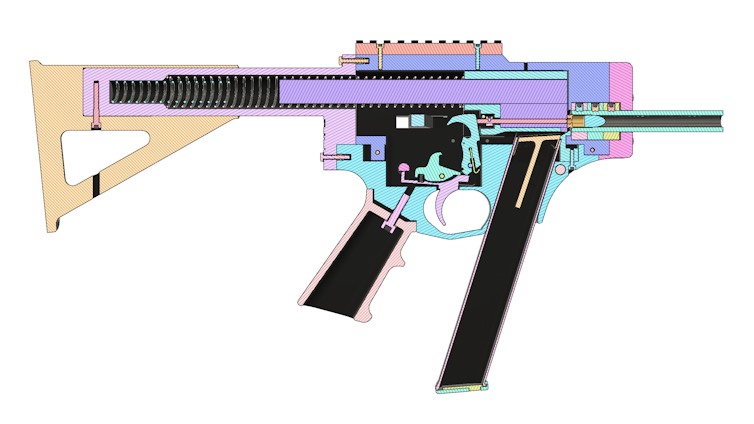‘Gun control is dead and we killed it’: unmasking the ‘lonely incel’ who designed the world’s most popular 3D-printed firearm

Every year, on Easter Sunday, Irish republicans commemorate their martyrs, remembering lives lost during the 1916 Easter Rising and in the years since. Such events have a pattern: a street parade, speeches and flowers at the cemetery.
The 2022 commemoration, however, was unusual for the presence of four men wearing balaclavas and dressed all in black. They were members of the dissident republican paramilitary group Óglaigh na hÉireann (ÓNH).

This was the group’s first public appearance since its ceasefire announcement in January 2018 – but it also carried wider significance for terrorism experts because of the weapons that two of the men were carrying. This was the first time paramilitary members in Northern Ireland had been seen with 3D-printed guns – specifically, a .22 calibre modification of the FGC semi-automatic firearm.
FGC stands for “fuck gun control”, and the acronym reflects the ideological leaning of its designer – and many others involved in the development of 3D-printed weapons.
The first 3D-printed firearm emerged in May 2013 with the release of the Liberator, a handgun created by Cody Wilson, a University of Texas law student and libertarian pro-firearms activist.
Essentially a proof of concept, Wilson let the BBC film him firing the gun before releasing the open-source design for anyone to download. Its release caused a sensation: the gun was pictured on the front page of the New York Post, with fears it could be smuggled past metal detectors on to planes (in fact, a metal detector would spot the gun’s metal firing pin and any ammunition).

Despite the hype, the reality was that the gun was impractical and unreliable. The Liberator could only shoot one bullet before it needed reloading, and was prone to falling apart from the pressure of being fired. The technology still had a long way to go, both in terms of the designs of the guns and the accessibility of 3D printing.
It was not until spring 2020 that the threat of 3D-printed guns grew significantly with the emergence of the FGC-9 (“9” denotes its 9mm bullets). This futuristic-looking, semi-automatic pistol calibre carbine required no regulated components and was fully DIY. About 80% could be made from plastic using a standard 3D printer, while the remaining metal parts could be fashioned from widely available steel tubes and springs.
The open-source design – which was quickly shared in many like-minded chatrooms – was accompanied by a meticulous, step-by-step instructional guide akin to an Ikea assembly booklet. All of this, the gun’s creator wrote, was to overcome “regulations and tyrannical laws” on gun ownership. Later, his group released a guide to making homemade 9mm ammunition.
Since then, we have seen evidence of the firearm’s use worldwide. It dominates online discussion of 3D-printed firearms and has been broadly adopted by various hobbyists, organised criminals, insurgents, and terrorists.
The gun’s mysterious designer, who used the pseudonym JStark1809 when he posted in chatrooms, estimated it would take a novice eight days to make the gun from scratch. He posted an upgraded Mark II version of the FGC-9 a year later, and boasted in one anonymised interview that, by bringing out these designs and sharing them freely: “We fucked gun control for good … Gun control is dead, and we killed it.”
Tracking 3D-printed guns around the world
Since the release of the FGC-9, the occurrence of 3D-printed guns has become more prevalent all over the world – from organised criminals in Europe to anti-junta rebels in Myanmar.
In May 2022, police stopped a car in Bradford in the UK and discovered a man transporting an FGC-9. Alongside two accomplices, he had been selling 3D-printed guns on the black market. A search of his accomplice’s house revealed many more FGC-9 components. In 2023, the trio became the first people in the UK to be convicted of trying to supply other criminal groups with 3D-printed firearms; they were sentenced to a combined 37 years in prison.
As a researcher at the International Centre for the Study of Radicalisation at King’s College London, I’ve been keeping track of this and many other cases around the world involving the production and use of 3D-printed guns.
This article is part of Conversation Insights.
The Insights editors commission long-form journalism, working with academics from many different backgrounds who are engaged in projects aimed at tackling societal and scientific challenges.
Several involve extremists. In Finland, police arrested a group of neo-Nazi accelerationists who had been printing and assembling FGCs in 2022. They posted videos online of them using a gun to shoot at the letterbox of an immigrant family. Three men were found guilty of committing crimes with terrorist intent and given jail terms.
In the UK, a teenager who reportedly took inspiration from the Unabomber was arrested in May 2023 after printing parts of the FGC-9. Jacob Graham was also accused of possessing bomb-making chemicals and publishing a guide on how to commit acts of terrorism. He was found guilty in 2024 and jailed for 13 years.
But FGC weapons are now being used most extensively in Myanmar, by pro-democracy rebels fighting the military junta. These insurgents have published photographs and videos of fighters making and using dozens of FGC-9s and a variation known as the Stingray, which has a longer barrel. They have used the gun in hit-and-run ambushes on government forces, as one insurgent leader explained, enabling the rebels to seize conventionally manufactured, higher-powered firearms from junta soldiers.
I first became aware of 3D-printed guns in October 2019, when a white nationalist livestreamed his attack on a synagogue on Yom Kippur in Germany. Stephan Balliet failed to get past its locked gate, and instead shot and killed two people nearby and made an escape.
Immediately before the attack, the 27-year-old German had posted a “manifesto” online and an inventory of the dozens of weapons he’d made at home. Balliet stated that one of his goals was to prove the viability of improvised, homemade weapons, including explosives and firearms. Some of these were made using a 3D printer, and he even uploaded the computer-aided design files for his weapons.
Balliet’s guns jammed frequently, however. He cursed the weapons on the livestream and said he was a failure. After trying to escape, he was eventually caught by the police, put on trial and given a life sentence. For any would-be terrorists watching, his attack was not a great advertisement for homemade firearms. But since then, more reliable and effective designs have been released on the internet, culminating in the the FGC-9.
The technology has become both cheaper and better. When Wilson created the first 3D-printed gun design in 2013, a 3D printer cost around £700. Today, an entry-level model costs a quarter of that price, and cheaper, stronger plastic polymers are readily available. A community of enthusiasts are also ready to guide novices along each step.
The legality of these firearms varies around the world: in the US, unlike in Europe, it’s generally legal to make a homemade firearm for personal use, though a license is typically required to sell them. Most 3D-printed guns don’t carry a serial number – in the US, these are known as “ghost guns”. Owning a ghost gun is legal in most US states, although a couple have introduced regulation. In New Jersey, for example, recent legislation requires all ghost guns to be registered and serialised.
Ideological origins
Cody Wilson had been strongly influenced by pro-gun, Second Amendment sentiments that are a prominent feature of US culture. As he told Forbes magazine in 2012: “Every citizen has the right to bear arms. This is the way to really lower the barrier to access to [those] arms.”
For Wilson and many others who followed in his digital footsteps, 3D-printed guns were an ideological issue. The original Liberator blueprint inspired others to develop new designs, and so a variety of gun enthusiasts, tech hobbyists and libertarian ideologues began coalescing online. They posted on Wilson’s Defense Distributed website and shared ideas in various online chat rooms. A community was forming, dedicated to advancing this new technology – designing new guns, releasing them online, and encouraging others to get involved.
One figure among them went by the name of Jacob. In chatrooms, he used the pseudonym JStark1809 – after Major General John Stark, who fought for the continental army in the American War of Independence (1775-1783) – and used his famous motto uttered in 1809: “Live free or die.”
Like Wilson, JStark was motivated by an ideology that saw bearing arms as a universal human right, as he explained in an interview with the Kommando Blog in 2019:
The ideal goal, the thing we are striving to do, is enable everyone around the world to manufacture firearms and ammo – to be able to have the right to bear arms everywhere, regardless of what the government says.
JStark established a group called Deterrence Dispensed (a play on Wilson’s Defense Distributed) and began working on a gun of his own – adapting an existing 2017 design, the Shuty AP9 pistol. When the digital blueprints for JStark’s FGC-9, a semi-automatic pistol calibre carbine, were released online in March 2020, it marked a watershed moment in 3D-printed and do-it-yourself firearms.

The gun was designed so that even its metal components were not regulated. They can be bought from online marketplaces, then repurposed to function as the barrel, bolt and other pressure-bearing parts of the gun.
This was more than just a technical innovation. The FGC-9, and its creator, became cultural phenomenons in the niche world of 3D-printed guns. JStark appeared in a Popular Front documentary about the gun, where his uncompromising views on gun ownership won him some admirers. Wearing a black balaclava and sunglasses, JStark was unequivocal:
We want people to have freedom of speech and the right to bear arms. If that’s too politically extreme for you, fuck yourself.
On the trail of the FGC-9 designer
When I first came across JStark, he was very careful about not giving away who he was or where he lived. Little was publicly known about him. On the rare occasions he was interviewed on camera, he appeared with his signature mask and sunglasses.
But many more details emerged in the autumn of 2021, when German current affairs magazine Der Spiegel published an investigation into “the shadowy, homemade weapons community [that] just keeps on growing”.
The article included an interview with “Jacob D” from Deterrence Dispensed – and it also revealed that he had died in the summer of 2021. Apparently, this was news even to his friends within the 3D-printed gun community.
Der Spiegel stated that this 28-year-old man of Kurdish origin had been living in the town of Völklingen in south-west Germany when he was arrested by police:
After months of investigation, the investigators launched a raid in late June [2021], with a commando storming his apartment. They found a 3D printer, several mobile phones, hard drives and a laptop, but no weapons. Jacob D. was allowed to remain free.
Two days later, however, he was apparently found dead in a car parked outside his parents’ home in Hannover. The article said an autopsy had been unable to determine the cause of Jacob D’s death, but that it had ruled out both foul play and suicide.
Perhaps inevitably, this report kickstarted various conspiracy theories among 3D-printed gun online communities regarding who may really have been responsible for Jacob D’s death. To some, he would come to be seen as a “martyr” for the cause of bearing arms, who risked his life so that others could make homemade guns like the FGC-9.
I discovered further clues to Jacob D’s identity in an interview from August 2019, when he referenced a Twitter exchange with Wilson in which he had criticised one of Wilson’s designs as “useless”. Jacob D said Wilson had told him to fix it himself (or words to that effect) – prompting him to “accept the challenge” and start creating designs of his own. This comment immediately struck me as revealing: would it be possible to find that Twitter exchange?
A quick search of Wilson’s Twitter feed pulled up a message from 2018 where he had replied “fix it” to a user, @thereal_JacobK. But that user had since been suspended, meaning I couldn’t look at their profile.
Fortunately, there’s an amazing online phenomenon whereby some people archive websites because they find them interesting – and post them for posterity for anyone to find. And someone had done that for @thereal_JacobK’s Twitter profile.
By now, I was convinced that @thereal_JacobK and Jacob D were the same person. And, following this digital trail, it was possible to discover his posts on other platforms, including one thread on 4chan’s Politically Incorrect board – an infamous section of the internet which initiates many memes and jokes, but also trolling and harassment campaigns.

4chan is ephemeral (posts are routinely culled) and supposedly anonymous (the default name setting for anyone posting is simply “Anonymous”). However, the website inserts a unique string of letters and numbers that stick with each person in any one thread – as a way of keeping track of who’s who in a conversation, while maintaining the veneer of anonymity.
This meant that, using the 4chan archiving site 4plebs.org, I was able to track @thereal_JacobK’s other comments in the thread, revealing hitherto unknown details about his life, including his frustration with living in Germany, his desire to move to the US, and his love for the Second Amendment. But perhaps most strikingly, he described himself as an incel – the term used by the misogynistic online community who define themselves as “involuntary celibates”.
Revealing the personality behind the gun
The way Jacob D wrote, anonymously, in that 4chan thread was also revealing. He only capitalised the word “I” at the start of a sentence – never after that. And he always inserted a space before an exclamation or question mark, which isn’t typical for Germans.
Analysing these writing habits is the domain of forensic linguistics, made famous for its use in the arrest of the Unabomber, Ted Kaczynski. These stylistic features meant I could track more of his comments in other conversation threads – with his repeat use of the same images sometimes giving an extra clue to threads he had been in.
Read more: How the Unabomber's unique linguistic fingerprints led to his capture
Eventually, I discovered threads in which Jacob D had uploaded photos of himself, including one where he showed his face. In part by using a facial recognition platform, I was then able to discover his old Soundcloud and Couchsurfing profiles – in the latter, he said he planned to travel to the US, “the country which fascinated me since my teens”, before he joined the German military.
And in both of these profiles, he revealed his real name: Jakob Duygu.

Ultimately, I have been able to track hundreds of supposedly anonymous posts that Duygu posted on 4chan and other message boards over the years. The FGC-9’s designer wrote about his life in Germany, his time in the Bundeswehr (German armed forces), and his loneliness and despair at being an incel. They show him as a complex, volatile, obsessive and tragic person. And they also reveal some extremist ideas.
The difference between these comments and those he made publicly in interviews (using his JStark1809 pseudonym) was striking. In interviews, he spoke about the need to protect free speech and human rights. He invoked the example of the genocide of European Jews in the Holocaust or the Uyghur people in China as arguments for why people need to have firearms, and why he created the FGC-9.
But when you look at his anonymous comments, a different picture emerges. Far from being a person concerned about human rights, his words were often xenophobic, racist and antisemitic. And this wasn’t exclusive to 4chan, which has a particularly offensive, obnoxious culture where perhaps not everything should be taken at face value.
The other thing that stuck out was his misogynism. Duygu regularly expressed the misogynist strain of incel thought that blames women for most of a man’s problems. He would say his looks, his race, his height and his autism all repelled women – and that as a result, he was doomed to a lifetime of loneliness and isolation.
Read more: Inside the warped world of incel extremists
But this was a side of his personality that he kept hidden from his public JStark1809 persona. I later learned that Duygu had various aliases in the incel world. He appeared on a podcast about incels, sharing his feelings that his autism and mental health issues were the main reasons for his inability to have sexual and romantic relations. He also appeared obsessed about his race, writing of his desire to be “white passing” to better his chances of finding a girlfriend.
There is concern that real-world violence can result from the misogyny and hatred towards women that is expressed by some online incel communities. The first high-profile murders carried out by someone who claimed to be incel-inspired were in May 2014, when 22-year-old Elliot Rodger killed six people in a stabbing and shooting spree at a campus of the University of California at Santa Barbara.

Four years later, 25-year-old Alek Minassian murdered ten pedestrians in a vehicle-ramming in Toronto minutes after praising Rodger in a Facebook post and claiming that “the Incel Rebellion has already begun!”. There is also evidence that incels are more likely to harm themselves than others.
Duygu’s online statements about incel violence varied – at times he condemned it, while elsewhere he condoned it. But in the final days of his life, he wrote that he would “literally kill or kill myself” if he couldn’t have intimacy with a woman again. This was the first time he had explicitly threatened violence because he was an incel. Coincidentally, he was arrested the following day – reportedly because he made a purchase online that was flagged as suspicious, which alerted the German police to who he was.
Duygu’s comments are also significant because he condoned and encouraged rightwing terrorism. He made several calls for people to “waste” some politicians and police officers, and complained there wasn’t a rightwing terrorist movement that had a “body count” in Germany. He hated the German political establishment, especially the country’s then-chancellor, Angela Merkel, and regularly complained about Muslim refugees entering the country – despite coming from a family of Kurdish Muslim asylum seekers who had settled in Germany in the 1990s.
Shedding light on Dugyu’s profile and behaviour is valuable when studying the latest terrorism trends. It highlights the potentially dangerous overlaps that can exist online between the incel community and extreme rightwing, xenophobic, racist communities, for example. At the same time, anyone can download the FGC-9 blueprints, regardless of what Duygu’s original intentions were when he first released the designs in 2020.
‘You can’t stop the signal’
The history of terrorism is characterised by a near-constant adoption of new technologies – from the invention of dynamite in the mid-19th century to the use of encrypted communication platforms and drones much more recently. The same is true with 3D-printed guns.
The technology will only improve in years to come. More effective, simpler designs will supplant the FGC-9. Plastic materials will become stronger and more reliable. The question is whether these innovations will lead to more widespread use of 3D-printed firearms and other weapons, including knives. The answer is probably yes.
Often, it can take just one event to signal to other would-be attackers a new way of killing people and committing mass murder. We saw this with vehicle rammings after the attack on Nice’s beachfront in 2016, claimed by Islamic State, which killed 86 people and injured hundreds more. In the months that followed, other jihadis across Europe used the same technique. The risk is that a high-profile, mass-casualty attack involving 3D-printed guns could inspire other people to do the same.
In the terrorist cases I have followed in Europe, all have involved rightwing extremists except for three instances: an anti-COVID extremist in Germany who was reportedly frustrated with the lockdowns and assembled an FGC-9 at home (for which he was given a suspended jail term); the dissident Republican ÓNH group who were filmed brandishing FGC firearms on Easter Sunday 2022; and the convicted British student Jacob Graham, who was described as having a variety of “anti-system” influences.
What we are seeing now are the early cases. The 3D-printed gun movement is still active after Duygu’s death, filled with hobbyists, gun enthusiasts and new designs. At its heart, this is an ideological movement not a commercial enterprise, although some people and organisations of course try to make money from 3D-printed guns.
In the material I’ve uncovered, Duygu was supportive of anti-establishment violence and far-right terrorism in Germany. But I also think he would have looked upon the developments in Myanmar, where the gun is being used by anti-junta insurgents, as exactly what he intended for the FGC-9.
Far from being hidden on obscure dark web forums, Duygu’s designs are relatively easy to access. To some, this is vindication of the core message of the 3D-printed gun movement – that you “can’t stop the signal”. Regardless of your own views about gun control or the proliferation of guns, the technology behind this new breed of weapons is now established, and it is not going away.

For you: more from our Insights series:
To hear about new Insights articles, join the hundreds of thousands of people who value The Conversation’s evidence-based news. Subscribe to our newsletter.
Rajan Basra does not work for, consult, own shares in or receive funding from any company or organisation that would benefit from this article, and has disclosed no relevant affiliations beyond their academic appointment.